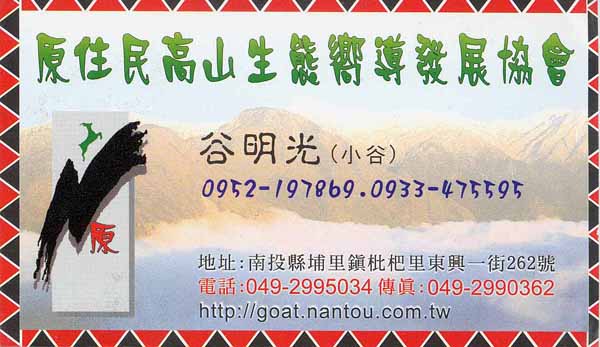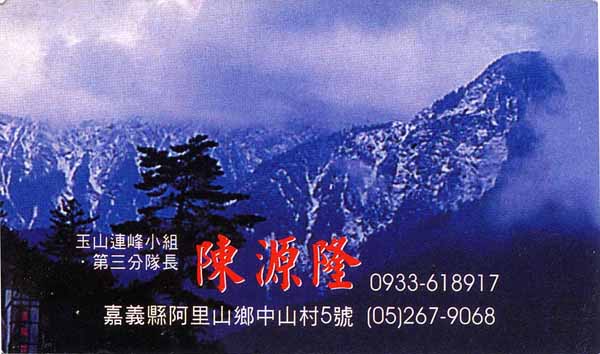
Nearrings and Nearfields
Chi-Tou, July 31—August 6, 2005
| 1st Announcement |
| 2nd Announcement |
| 3rd Announcement |
| The Program |
| Tourist Information |
| Registered |
| 2003 Participants |
| The talks |
| Photos |
Please find below some tourist and travel information about Taiwan.
TOURIST INFORMATION
Taiwan is well-known for its high-tech industry, and people may assume that it is over-populated and with factories everywhere. It may surprise the visitors to discover that 2/3 of the island is set aside as National parks. Taiwanese strive to incorporate the best the West has to offer and blend it with its Asian root and has culture that is quite charming to visitors.
On the Destinations page of the site Taiwan Ho! Photo Gallery you can find photos of various places of interests. Taiwan is also listed in Lonelyplanet website. Click on the map to see information they have provided. Here are a few places that may interest the visitors.
First of all, the conference will take place in Chi-Tou (or spelled Hsi-Tou), a forest recreational area owned by National Taiwan University. Chi-Tou is located in the center part of Taiwan (Nan-Tou County). Although earthquake once hit Nan-Tou County seriously, Chi-Tou was hardly moved. At an elevation of 2000 m above sea level, it will be just nice for the conference during the summer time. There are about 300 different species of trees and about 70 different species of birds in the area. There are trails designed for easy access to the wealth of the area as well. So bring a binocular with you to the conference if you like birds.
Taipei is the largest city in Taiwan with a population of 2.5 million. If you arrive in Taipei, you might choose to stay in the city for one to two days. You can walk in the downtown area and experience the mixture of old and modern style of Chinese architecture. The current reigning tallest building in http://www.npm.gov.tw/en/home.htmt part of the city. The famous Palace Museum also resides in Taipei. It hosts a large portion of the Chinese imperial treasure brought over by Chan Kai Shek in the late 40’s . A river runs through Taipei and there is a Fishermen’s Wharf in the northern tip where the river leaves the city. It is a typical tourist place with quaint shops and historical places.
The second largest city in Taiwan is Kaohsiung, 50 km south of Tainan. If you choose to visit Kaohsiung, I suggest a stay in the guest hotel of National Sun Yat-sen University which is located between a beach and a hill with a breath-taking view. You can hike the hill and say hello to monkeys who live there, and then take a bath in Southern China Sea. From the university, it is a convenient short walk over a bridge to a small island outside Kaohsiung Harbor where you can find various places that serve fresh seafood.
Here are some other places of interest:
Ping-Tong, the county east of Kaohsiung, is famous for its agriculture landscape and subculture. It also has the National Aquarium with a rich collection of species. The variety of fishes and other sea animals is incredible. Also the architecture of this aquarium is of interest in itself.
Hsiao Liu-chiu, a small island off the coast of Ping-Tong, has a mixed atmosphere of urban and nature. On this island, you can go scrubber diving or take a submarine ride and watch the beautiful ocean floor. One can also go and visit the caves there and hear the folklores associated with them. Of course you should try their famous tuna.
Kenting National Park at the southern tip of the island is a great place for swimming. However as Taiwan wants Kenting to be attractive for foreigners, Kenting is losing some of the charm it once had. On the other hand, it has become much more convenient for foreigners to reach this area.
Opposite of Kenting, Green Island (photos) is a good example of the nature which has untouched by the civilization. You may encounter small deer wandering not far from your hotel, watch many exotic fish in the caves and take open thermal bathes moving from hot springs to the ocean. Green Island is located in the Pacific Ocean east of the island, and can be reached via small airplanes or boats from the city of Taitung.
With a peak of 3952 m above sea level, Yushan (Jade Mountain) marks the highest point in east and south-east Asia. The scenery is breath-taking. One must obtain a hiking permit ahead of time (usually more than a month) in order to climb Yushan all the way to the to and this is not permitted from late December to early March. However many places of lower elevation remain open all year round. It is also a pleasure to bath in hot spring sand to sleep under the lullaby of a mountain river.
The following travel agent is specialized in arrangment of traveling in Taiwan. Please inquire directly.

The following mountain guides are professional. But they speak only Chinese.


Contact:
wfke@maill.ncku.edu.tw
Organizing Committee:
Yuen Fong and Wen-Fong Ke